SIUE 50th Anniversary Historical Timeline
(CLICK HERE FOR PRINTABLE VERSION
)
Compiled by
Dr. Stephen Kerber
University Archivist & Special Collections Librarian
Lovejoy Library
1950's |
1960's |
1970's |
1980's |
1990's |
2000's
- At a meeting in the First National Bank building, the board members of the Edwardsville Chamber of Commerce established a College Planning Committee under the chairmanship of George L. Moorman, Sr. The committee formulated plans to invite representatives of the University of Illinois and Southern Illinois University to meet with them in order to discuss ways and means of establishing a public institution of higher learning in Southwestern Illinois.
1955: September 1
- Dr. Harold W. See became the director of the Belleville Residence Center.
1955: October 19
- Dr. Harold W. See duly met with the members of the College Planning Committee as the representative of Southern Illinois University, while the other institution failed to send a representative. In the weeks and months that followed, See assumed the unofficial role of mentor to the committee and intermediary between the community leaders and the university.
1956: September 25
- The College Planning Committee invited 150 local dignitaries with an interest in the establishment of a local public institution of higher learning to a meeting at the Sunset Hills Country Club in Edwardsville. The Sunset Hills meeting resulted in the formation of a much larger and more inclusive regional advocacy group known as the Southwestern Illinois Council for Higher Education (SWICHE).
1956: October 23
- At a meeting in Carbondale involving the SWICHE executive committee and the SIU Board of Trustees, Dr. Robert Lynn of Alton pled for swift action to provide convenient access to higher education for residents of Southwestern Illinois. The board voted unanimously to "express its profound interest in the serious situation in regard to higher educational facilities in the southwestern area of Illinois" and to "make accelerated provision for higher education facilities in the said area as quickly as necessary state and other funds become available."
1956: November 11
- The trustees voted unanimously to establish additional residence centers in one or more communities beside Belleville.
1957: June 25
- Dr. Harold W. See received appointment effective July 1, 1957 as Executive Dean of a newly-created Southwestern Illinois Residence Office for Madison and St. Clair counties.
1957: July 1
- Classes began at the Alton Residence Center on the former campus of Shurtleff College in Alton.
1957: September 16
- Geri Kay Howell of East St. Louis became the first student to register for fall quarter classes at the new residence centers.
1957: September 24
- Day classes began at the Alton and East St. Louis residence centers. Under a temporary arrangement, students attended classes in the Morrison School, on 59th Street north of State Street, in East St. Louis. A brief opening ceremony took place on the playground of the Morrison School.
1958: April 29
- The Southwestern Illinois Council for Higher Education (SWICHE) appointed a committee to raise funds from private sources in order to purchase land for a new campus in Southwestern Illinois.
1958: June 15
- The first students to complete their college studies at the residence centers received their degrees during commencement.
1958: June 24
- Dr. William Going, professor of English, received appointment effective July 1, 1958 as dean of instruction.
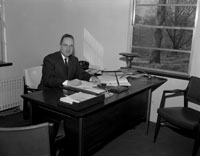
1959: January 19
- Mr. and Mrs. Clarence O'Brien of Lewis Road sold the first piece of property that would become part of the university campus.
1959: April 1
- Executive Dean Harold W. See received appointment to the position of Chief Executive Assistant for the Southwestern Illinois Campus with the title of Vice President for Southwestern Illinois Campus.
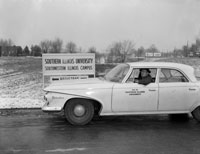
1959: April 16
- William H. and Florence Rohrkaste sold two parcels of land, including 153.15 acres, for inclusion in the campus.
1959: May 27
- Representatives of the Southwestern Illinois Council for Higher Education (SWICHE) and area legislators met with Governor William Stratton and informed him that 60,000 citizens of Southwestern Illinois had contributed more than $592,000 to purchase property for the campus.
1959: October 30
- The Illinois Terminal Railroad Company sold the title to the interurban railroad right of way across the emerging campus.
1959: December 18
Vice President Harold W. See relocated his administrative offices from the Broadview Hotel in East St. Louis to the former home of Mrs. Edwin Gerling on Fangenroth Road in the south central area of the new campus site. Those administrative employees moving with See included his associates, Dr. H. Bruce Brubaker and Dr. Raymond J. Spahn, Dr. William Going (dean), Mr. Emery Casstevens (industrial and technical programs) and the central secretarial and clerical staff. Some library and registrar employees had moved into other "tract houses" earlier.
Back To Top
1960: March 4
- Six "divisions" of academic programs--humanities, science, social sciences, fine arts, education, and business--came into existence, each managed by a "head of division." Previously, a "director" at each residence center had reported to Dean of Instruction William Going. No departments, schools, colleges, or other instructional units had previously been established.
1960: May 7
- The following received appointment, effective July 1, 1960, as acting division heads: Dr. Kermit G. Clemans (science); Dr. John J. Glynn (business), Dr. Nicholas T. Joost (humanities); Dr. Cameron W. Meredith (education); and Dr. Herbert H. Rosenthal (social sciences).
1960: May 14
- Eighty students took part in a leadership training program at the Sunset Hills Country Club and participated in the first organized student tour of the new campus site.
1960: May 16
- The executive committee of the Southwestern Illinois Council for Higher Education (SWICHE) met in Alton and voted active involvement in and support of the November 1960 bond issue to provide permanent improvements for higher education in Illinois.
1960: May 24
- Dr. Howard V. Davis, director of student affairs, acting at the suggestion of the joint student council, announced the appointment of student staff members for a new unified campus newspaper and a student yearbook. During the previous two years, students at the Alton Residence Center had produced their own paper called the ARC.
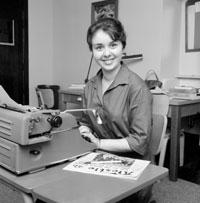
1960: June 14
- Governor William Stratton addressed the first graduation ceremony held on the campus, at a site just off U.S. Bypass 66, and strongly endorsed passage in November of the state universities bond issue. Prior to the ceremony, the governor received a guided tour of the campus, followed by an outdoor buffet supper on the lawn of the administrative offices on Fangenroth Road.
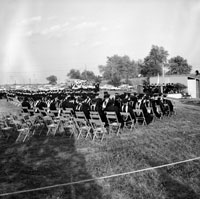
1960: June 15
- The following firms engaged to create a campus master plan for the property being acquired: Helmuth, Obata, and Kassabaum of St. Louis (architectural planning); Hare and Hare of Kansas City (city planning and landscape architecture); and Warren and Van Praag of Decatur, Illinois (professional engineering).
1960: September 25
- State Senator Lloyd Harris (D) of Granite City assured labor leaders at a meeting that his amendment to the state universities bond issue bill would allocate twenty-five million dollars for building the new campus.
1960: October 3
- More than 1,500 persons attended a bond issue rally held on the new campus. During the festivities, an exasperated neighboring landowner allegedly shot at a helicopter carrying out aerial tours of the area because the noise had disturbed his livestock.
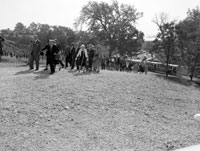
1960: November 2-5
- Forty-five student volunteers from the residence centers participated with students from other schools in a marathon run across the state in order to draw public attention to the state universities bond issue on the general election ballot. On Saturday morning, November 5, sophomore Richard Ryan of East St. Louis represented his fellows on the final stretch of the run into Chicago.
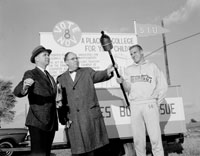
1960: November 8
- Voters in Madison, St. Clair, and Cook counties provided the margin of victory for the state universities bond issue that subsequently financed the construction of the original SIUE campus infrastructure and buildings as well as the Chicago Circle campus of the University of Illinois.
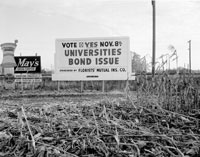
1960: November 29
- Vice President Harold W. See received abrupt, unsought reassignment as research professor of higher education. The stunning removal of See led to protests by students, faculty members, and local citizens.
1961: January 16
- Purchase of a 132-acre horse farm from Mr. and Mrs. Leopold Freund provided the keystone piece of property for the new campus.
1961: February 18
- The Ford Foundation made a grant of $50,000 in support of the innovative campus planning process.
1961: March 15
- Warren Stookey became the first representative for alumni services and the university foundation.
1961: March 28
- The board of directors of the foundation met on campus for the first time.
1961: March 29
- Illinois Governor Otto Kerner announced the appointment of Arnold Maremont, Chicago industrialist and patron of the arts, to the board of trustees.
1961: April 17
- An announcement described an extraordinary public seminar featuring noted experts in the realm of planning--Environmental Planning Edwardsville Campus or EPEC--to be staged in East St. Louis at the suggestion of trustee Arnold Maremont.
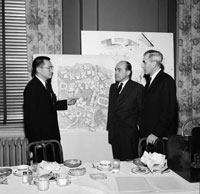
1961: June 2
- The EPEC seminar took place in an inflatable bubble structure on a parking lot in East St. Louis. EPEC featured seven in-person speakers (Gyo Obata, Edmund Bacon, Howard Becker, Earl Bolton, Sybil Moholy-Nagy, Hideo Sasaki, and Paolo Solieri), plus six filmed presentations (Josef Albers, Reyner Banham, John Burchard, Andrew Ritchie, and Eric Larrabee), and a continuous multiple slide projector exhibit entitled "MANSCAPE."
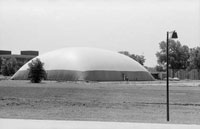
1961: June 12
- Students received copies of the initial campus yearbook, entitled the Muse, edited by Carole McDonald of Granite City.
1961: June 15
- Two academic divisions underwent name changes: science to science and technology and social studies to social sciences.
1961: August 11
- Dr. Clarence Stephens received assignment as vice president for operations, succeeding former Vice President Harold W. See in the administrative leadership role.
1961: November 9
- Following a presentation by Gyo Obata and University Architect Charles Pulley, the board of trustees approved a revised campus master plan.
1962: May 1
- A soil drilling crew began to make a series of forty test borings in order to gather information about the character of the soil on campus.
1962: May 16
- Trustee Arnold Maremont admonished the Edwardsville Chamber of Commerce by warning that a mistake may have been made in locating the campus near Edwardsville if the local people did not want it enough to adopt zoning.
1962: May 26
- Preliminary designs for the first campus buildings received board approval.
1962: June 9
- Purchasers acquired the former Freund home, two barns, and six outbuildings at a public auction on campus.
1962: September 14
- Trustee Arnold Maremont persuaded his colleagues on the board to refuse to proceed with entering into contracts for the construction of campus buildings until Madison County had established a zoning ordinance.
1963: February 20
- The Madison County Board of Supervisors finally enacted the first county zoning ordinance. Immediately, the administration authorized invitations for bids on the first two campus structures, the library and the general classroom and office building.
1963: May 2
- The official groundbreaking ceremony took place near the site of what had been the Freund home and what would become the center of campus.
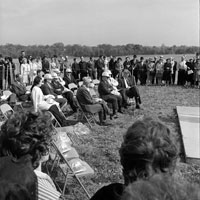
1963: June 14
- The commencement ceremony took place for the first time at a natural amphitheater site on the northern side of campus just west of Lewis Road and south of the intersection with Poag Road. Subsequently, in 1969, the amphitheater became the site of the Mississippi River Festival. Robert Weaver, administrator of the Federal Housing and Finance Agency, served as commencement speaker and became the first recipient of an honorary degree.
1963: June 28
- Ignoring several requests that the anticipated library building be named in honor of former Vice President Harold W. See, the trustees instead designated the structure as the Lovejoy Memorial Library after Alton newspaper editor Elijah P. Lovejoy.
1963: September 17
- The property acquired for the campus included a huge elm tree that stood 77 feet high, measured more than 6 feet in diameter, and had a spread of 125 feet. Sadly, the monumental tree, a landmark in the region, fell victim to Dutch elm disease and had to be removed on this date.
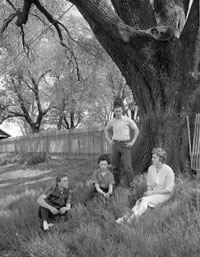
1963: October 3
- The trustees approved the purchase of the Wagner Electric Corporation property in the city of Edwardsville.
1964: March 29
- Effective with the start of spring quarter, the nursing program opened.
1964: May 28
- The trustees designated the general classroom building then under construction as the John Mason Peck Building to honor that educational pioneer and author.
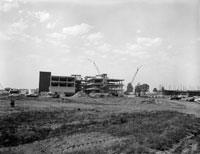
1965: September 23
- Classes began on the new Edwardsville campus. Only the Peck Building and Lovejoy Library had been put into operation.
1965: December 11
- The new main entrance road from Illinois 157 received designation as "University Drive."
1966: May 13
- A year of formal dedication ceremonies began.
1966: September 21
- The Science Building, third of the original buildings, began operation.
1966: December 5
- The original two lanes of South University Drive opened to traffic.
1967: January 3
- The Communications Building, the fourth structure, opened for use.
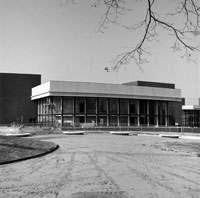
1967: March 3
- The dedication of the University Center took place.
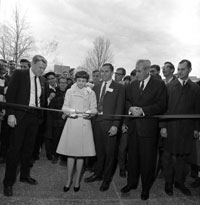
1967: May 26
- Workers constructed the campus water tower during the winter of 1964-65. On May 26, 1967, the trustees named the nearby utilities reservoir or lake that had been created to provide water for the heating and cooling plant after the new water tower--Tower Lake.
1967: June 9
- Raymond Franks Jr. of St. Louis and Michael Blackburn of Caseyville became the first Air Force ROTC cadets to receive their commissions.
1967: October 7
- At the conclusion of a three-day Labor Institute, participants placed a memorial plaque beneath the national flagpole in honor of the five workers who had died during construction of the campus.
1967: October 10
- To conclude the festivities of the dedicatory year, a ceremony marked the burying of a time capsule on the campus mall.
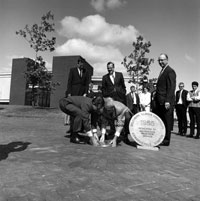
1967: October 11
- The Cougar soccer team won the institution's first official intercollegiate victory at Blackburn College.
1967: October 25
- In their first home game, on a field north of the Peck Building, the soccer Cougars lost to a team from Harris Teachers College.
1967: December 6
- Under the direction of coach Harry Gallatin, the founding basketball team practiced in the Alton gym and played its home games at Edwardsville High School. After losing their first two contests on November 22 and 24, the cagers won their opening home game against Sanford Brown of St. Louis on December 6.
1968: February 19
- Junior Walter Parrill and Alumni Association director Warren Stookey flew to Houston, Texas, to pick up a young female cougar called Danielle. Renamed Chimega at the suggestion of student Mary Ann Kucinick, the newcomer became a beloved living mascot. A student volunteer organization named the Cougar Guard began caring for the mascot in January 1969 and Chimega moved into her permanent home south of the University Center, a cage topped with a geodesic dome designed by Buckminster Fuller, in June 1970.
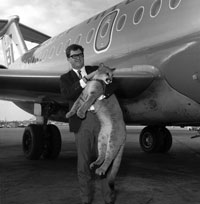
1968: April 3
- The inaugural Cougar baseball team lost their initial contest at McKendree College.
1968: April 5
- Members of the university community gathered in the Communications Building theater to pay tribute to the memory of the martyred Dr. Martin Luther King, Jr.
1968: April 10
- In their first home game, on a diamond northwest of the Science Building, the Cougar baseball team defeated Harris Teachers College to achieve its first victory.
1968: July 1
- John Rendleman became chancellor effective this date.
1968: September 24
- The second two-lane portion of South University Drive opened.
1968: September 27
- Student Christine Pashoff cut the ribbon that marked the opening of the newly-completed second floor of the University Center. New facilities included the University Club restaurant, offices for nursing and business faculty members, and the Meridian Ballroom.
1968: October 5
- The men's cross country team won its very first intercollegiate meet against Millikin University.
1969: January 29
- The Federal Communications Commission granted approval for the construction of a noncommercial university FM radio station (88.7 megahertz).
1969: March 17
- A news conference heralded the initial plans for a summer outdoor music festival on campus featuring classical music performed by the St. Louis Symphony Orchestra as well as contemporary folk, pop, and rock music.
1969: April 8
- University News Service employees moved into the brand-new General Office Building, across the Hairpin Drive from the Peck Building, joining fellow workers from the registrar's office who had previously occupied their new space in February.
1969: April 18
- The trustees voted to establish a School of Dental Medicine.
1969: April 21
- The Federal Communication Commission approved the call letters WSIE for the anticipated campus radio station.
1969: June 20
- Following a gala "Pique-nique" social event on the central mall, the Mississippi River Festival began with a concert by the St. Louis Symphony Orchestra under the direction of Walter Susskind.
1969: June 23
- Cree Indian singer Buffy Sainte-Marie opened the popular music season at the MRF.
Back To Top
1970: March 28
- The new track team (coached by Jack Whitted) inaugurated competition with a loss to Washington University.
1970: May 4
- Ohio National Guardsmen shot and killed four anti-Vietnam War demonstrators at Kent State University. On the following day, Chancellor John Rendleman held an open forum in the Goshen Lounge of the University Center and responded to comments and questions from outraged students.
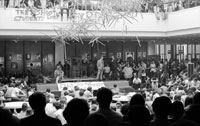
1970: May 15
- In response to disorder and violence at that institution, the governor of Illinois closed Southern Illinois University at Carbondale.
1970: May 17
- Ronald Yarbrough, earth sciences professor, received the first Great Teacher Award from the SIUE Alumni Association at Honors Day.
1970: May 18
- Chancellor Rendleman held a campus convocation or "moratorium" on violence, followed by additional convocations over the following three days. Rendleman's public opposition to the war in Vietnam and his willingness to engage in dialogue helped to prevent violence at the university during these troubled times.
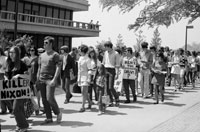
1970: September 4
- Radio station WSIE began broadcasting.
1970: November 15
- Dedication of the initial phase of the first on-campus housing at Tower Lake took place.
1971: September 1
- Chancellor John Rendleman assumed the title of president effective this date.
1971: October 18-24
- Dedication ceremonies for the privately-financed Religious Center took place, highlighted by a speech by Buckminster Fuller on October 22.
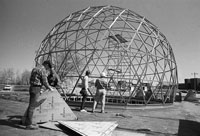
1972: April 26
- President John Rendleman threw out the ceremonial first pitch at the dedication of the Cougar Field baseball diamond.
1972: August 31
- Governor Richard Ogilvie released $14,266,300 previously-appropriated funds for construction of two new classroom-office buildings.
1972: September 5
- The School of Dental Medicine began classes at the former Shurtleff College campus in Alton.
1972: October 3
- Dean Frank Sobkowski presided at dedication ceremonies for the School of Dental Medicine.
1972: October 4
- Intercollegiate sport competition for women began. In a home game, Barbara Maue scored twice as the field hockey team defeated Greenville College by a score of two to one. Rosemarie Archangel, women's athletic director, also served as the field hockey coach.
1972: October 16
- Antiwar activist and actress Jane Fonda spoke in the Meridian Ballroom of the University Center.
1973: March 29
- Groundbreaking ceremonies took place for two new classroom-office buildings to be located north of the Peck Building.
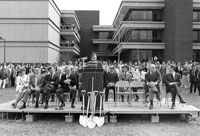
1973: June 9
- Shirley Stimac of Wood River became the first woman to earn a degree in engineering from the university when she graduated with a bachelor's degree in urban and environmental engineering.
1973: July 25
- A misguided sociology class "experiment" went badly awry when a female student calling herself "Jane Loemke" set up signs in a classroom building advertising for a husband to share a mythical $100,000 inheritance from a rich uncle. An Alestle story created extensive publicity and unanticipated consequences for the student and instructor.
1973: September 4
- President John Rendleman nominated Dr. Vaughnie Jean Lindsay of the business faculty to become dean of the graduate school, succeeding Howard Dye.
1973: September 6
- In order to permit second-year students to acquire practical training, the School of Dental Medicine opened a new dental clinic on the Alton campus.
1973: November 2
- A canvass of votes indicated that Don Hastings, a sophomore from Edwardsville, had been elected as the first non-voting student representative on the board of trustees.
1974: February 21
- Two legendary television stars of the 1950s, Buffalo Bob and his puppet, Howdy Doody, appeared in the Meridian Ballroom during Winterfest 1974.
1974: March 8
- A group of streakers attracted a small crowd to the central mall. Nationally, according to historical researchers, the craze of collegiate streaking peaked between March 1 and March 9, 1974.
1974: May 3
- Chimega, the university's live Cougar mascot, gave birth to two cubs. Sadly, one cub was stillborn and the other died within hours of birth.
1974: October 15
- Actor Leonard Nimoy of Star Trek fame lectured to a capacity crowd in the Meridian Ballroom.
1975: May 23
- President John Rendleman announced that the School of Dental Medicine had received full accreditation by the American Dental Association.
1975: July 10
- Effective with the start of winter quarter 1976, the trustees raised textbook rental fees for students taking eleven to seventeen quarter hours from $8.00 to $10.00 and for students taking over seventeen quarter hours to $12.00.
1975: July 21
- The faculty approved the constitution and bylaws for a new Faculty Senate.
1975: August 9
- The first class to complete the School of Dental Medicine program graduated at a ceremony in the Communications Building theater. The school later adopted a four-year curriculum in the fall of 1978.
1975: October 17
- Dedication of the Tower Lake II housing complex took place.
1975: November 25
- Groundbreaking took place for construction by trainees of a connector road between Circle Drive and Bluff Road known as the Whiteside Southwest Connector Training Roadway. The new road replaced a farm lane across property homesteaded by William Whiteside early in the nineteenth century.
1976: March 4
- President John Rendleman died of lung cancer.
1976: March 11
- Following the untimely death of John Rendleman, Andrew Kochman became acting president effective this date.
1976: March 17
- In tribute to the late president's memory, a ceremony marked the naming of the General Office Building in honor of John Rendleman.
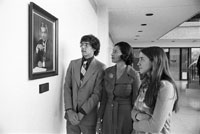
1976: May 6
- Laura Lee Ricci won election as the first woman student body president.
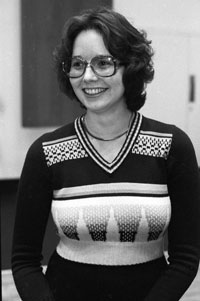
1976: May 13
- Acting President Andrew Kochman presided over the dedication event for Building II (today's Founders Hall) and Building III (Alumni Hall).
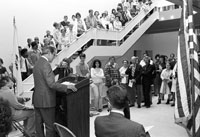
1976: June 11
- Dr. John Abbott, director, announced that the Friends of Lovejoy Library support organization had donated $14,750 to pay for installation of a "tattletape" electronic security system designed to prevent theft of Lovejoy Library books.
1976: July 23
- The North Central Association of Colleges and Schools announced that it had granted the university accreditation at the doctoral level.
1976: October 14
- Senior Vice President for Planning and Review Ralph Ruffner assumed the role of acting president effective this date.
1977: January 17
- Kenneth "Buzz" Shaw assumed the presidency of the university effective this date.
1977: March 10
- The trustees decided to raise tuition for the first time in six years. From the standard figure of $143 per quarter for full-time Illinois residents, tuition increased $30 per quarter for undergrads, $40 for graduate students, and $180 for dental students.
1977: July 31
- During a huge Sunday evening birthday party held in his honor at the Meridian Ballroom of the University Center, state Senator Sam Vadalabene received and shared the contents of a welcome communication from Governor James Thompson. The governor announced his intention to sign senate bill 314 that would fund the long-awaited initial planning for the university's first permanent physical education building.
1977: September 20
- President Buzz Shaw initiated an institutional tradition by delivering his first comprehensive state-of-the-university address in the Communications Building theater.
1977: September 26
- An announcement revealed that monetary fines for parking violations would be increased. For expired meter time or parking on a roadway, fines would increase from $1 to $2. For parking in a no parking zone, fines would increase from $1 to $5.
1978: May 25
- Installation ceremonies marked the establishment of a chapter of the Phi Kappa Phi honor society.
1978: June 23
- President Buzz Shaw announced the selection of twenty high school seniors with high academic potential as the first group of Presidential Scholars.
1979: February 8
- The trustees reversed the trend toward autonomy that had prevailed since 1970 by establishing a new system governance structure featuring a "chancellor" to whom the presidents of the two universities would report.
1979: April 12
- In order to comply with the direction of the Illinois Board of Higher Education so as to eliminate duplication of effort with the State Community College in East St. Louis, the trustees approved the phasing out of the Experiment in Higher Education program in East St. Louis by June 1982.
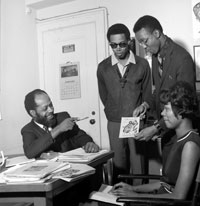
1979: June 14
- The trustees approved a recommended location east and slightly north of the Bubble Gym as the site for the anticipated physical education building.
1979: September 15
- Earl Lazerson became acting president of the university effective this date, succeeding Buzz Shaw who became chancellor of the system.
1979: September 15
- During their inaugural competition, the women's cross-country team placed three of its four runners in the top fifteen at the Washington University Invitational.
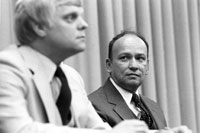
1979: October 6
- Acting President Earl Lazerson initiated the annual Preview SIUE open house event for high school students and their families.
1980: February 20
- In a departure from the traditional Winterfest celebration, workers filled the University Center's atrium lounge with ten tons of sand to create a "Goshen Ocean" for volleyball and sandcastle construction.
1980: May 15
- Six brand-new tennis courts, constructed in a small amphitheater west of the anticipated physical education building, opened as the scene of the NCAA's Division II national championship tournament.
Back To Top
- The university awarded its first doctoral degrees.
1980: June 26
- A ceremony marked the final completion of and the opening of the Whiteside Roadway connecting Circle Drive and Bluff Road.
1980: July 10
- Earl Lazerson became president of the university effective this date.
1980: July 31
- Governor James Thompson attended a birthday gathering for state Senator Sam Vadalabene and promised to sign senate bill 1665 appropriating the funds for construction of the physical education building.
1980: August 29
- A new satellite dental clinic opened in East St. Louis.
1981: January 14
- The new meeting rooms forming a conference center facility on the second floor of the University Center opened with a series of dedication activities. Six rooms subsequently received the names of trees found in the region: Hackberry, Red Bud, Maple, Dogwood, Oak, and Hickory.
1981: May 18
- Cold rain drove the dignitaries gathered to perform the groundbreaking ceremony for the physical education building inside the nearby Bubble Gym.
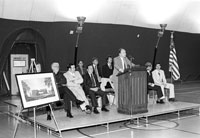
1981: May 22
- Officials announced that there would be no Mississippi River Festival season during the summer of 1981.
1981: July 20
- A windstorm destroyed the original Bubble Gym.
1982: January 5
- The Illinois Board of Higher Education concurred with a report from its dental education committee and approved continuance of the School of Dental Medicine.
1982: June 8
- The dedication of a giant mosaic called the Rainbow Connection, affixed to the wall of Building III, took place during the annual Very Special Arts Festival.
1982: September 30
- President Emeritus Clark Kerr of the University of California delivered the convocation address as the university initiated the celebration of its twenty-fifth anniversary.
1983: June 2
- Officials announced that a new program of academic courses to be held only on Saturdays and Sundays and called Weekend University would begin with the start of fall quarter 1983.
1983: June 10
- In a major change of location, the commencement ceremony took place not at the MRF amphitheater site used since 1963 but on the lawn space bounded by the Hairpin Drive, east of the campus mall and between the Peck and Rendleman buildings. No further commencement ceremonies took place at the amphitheater site.
1983: November 2
- Homecoming 1983 featured the return of the concept of a king and queen for the first time since 1969.
1984: February 17
- Officials announced that a new one-month-long, intensive academic term to be called September Option would debut during the fall of 1984.
1984: March 27
- President Earl Lazerson informed the university community that he had received the final report of a task force on academics and athletics established by him in response to reports of irregularities in the intercollegiate athletic program. The task force established the guiding principle that the goals of the athletic program are subservient to the goals of the general academic program.
1984: May 6-7
- As part of the twenty-fifth anniversary year, the first Founders celebration took place honoring the members of the Southwestern Illinois Council for Higher Education, the landowners, the contributors to the land purchase fund, the laborers who died in construction accidents, and the original faculty and staff.
1984: May 7
- Illinois Governor James Thompson journeyed to Edwardsville to join in paying tribute to state Senator Sam Vadalabene at the dedication ceremony for the physical education facility long-championed by Senator Sam and named in his honor.
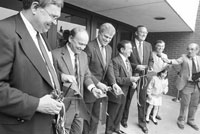
1984: May 25
- South of the Bubble Gym, on a site previously occupied by handball courts, the newly-constructed Student Experimental Theater opened on this date. It replaced the old Quonset Hut as a venue for student-initiated productions. A ceremony just a year later, on May 22, 1985, renamed the facility for James F. Metcalf, longtime budget director.
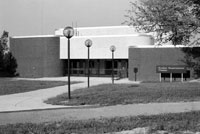
1984: July 1
- The university joined the other state schools in adopting the 37 ½-hour work week.
1985: March 12
- Chimega, the beloved original Cougar mascot, died at the age of seventeen.
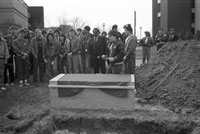
1985: May 2
- The Friends of Lovejoy Library opened their Good Buy Book Store in the basement of the library.
1985: September 27
- Groundbreaking took place for an Early Childhood Center building and for an outdoor swimming pool facility at Tower Lake.
1985: October 23
- The Arts & Issues series premiered with an appearance by former ambassador George Ball.
1986: April 24
- A celebration marked the dedication of the newly-finished Early Childhood Center. Sandra LaVernn Wilson served as director of the ECC from June 6, 1971 through February 29, 2000.
1986: April 26
- Between games of a doubleheader on this date, a dedication event renamed Cougar Field in honor of longtime baseball coach Roy Lee, who had died on November 10, 1985.
1986: November 1
- A ceremony marked the naming of the soccer field in honor of the founding coach, Bob Guelker, who had achieved a record of 216-67-21 at SIUE. Guelker had died on February 22, 1986.
1986: December 18
- President Earl Lazerson announced the awarding of nearly one million dollars in internally-reallocated funds to 105 projects as part of his Excellence in Undergraduate Education initiative.
1987: June 5
- The dedication of the new clinic building at the School of Dental Medicine took place.
1987: June 26
- The era of live campus mascots ended with the hasty and unceremonious removal of Chimega's successor, Kyna. Destruction of the cougar cage followed immediately.
1988: May 20
- The Tower Lake swimming pool dedication ceremony took place.
1988: July 20
- Officials announced the appointment of Cindy Jones as the first woman athletic director.
1989: March 6
- A heavy late-season snow and ice storm destroyed the second Bubble Gym.
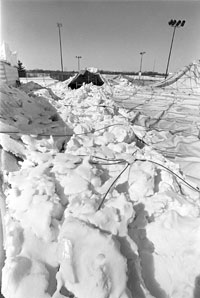
1989: April 7
- Groundbreaking occurred for the University Park research facility.
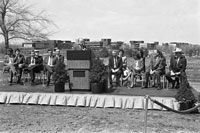
1989: May 20
- The inaugural Great Cardboard Boat Regatta took place.
Back To Top
1990: March 22
- Due to extensive damage caused over the holiday break when an accident covered the Vadalabene Center gymnasium floor with water, the Illinois Capital Development Board awarded a contract to replace the floor.
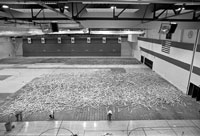
1990: April 17
- Dean Donal Myer of the School of Sciences announced plans for creation of a campus arboretum. First suggested by environmental sciences professor Frank Kulfinski, the anticipated site for the arboretum would be located north of the Tower Lake recreation area parking lot. Following the subsequent death of Myer on August 6, the trustees named the arboretum in his honor.
1990: May 15
- Groundbreaking took place for the initial building to be erected in University Park.
1990: July 18
- Officials revealed that the name of the University Ambassadors organization, university student volunteers who provided scripted information and tours to visitors and prospective high school students, would be changed to Students Assisting in Recruitment or STARS.
1990: September 23
- The Friends of Lovejoy Library, the pioneer support organization on campus, hosted a twenty-fifth anniversary party for the library.
1990: October 10
- Ceremonies in the University Center marked the twenty-fifth anniversary of the opening of the campus.
1990: December 13
- The trustees named the anticipated arboretum in memory of Professor Donal G. Myer who had died on August 6, 1990.
1991: March 14
- The trustees approved a proposal to convert the academic calendar from the quarter system that had been in existence since 1957 to the semester system effective in fall 1993.
1991: May 8
- The Friends of Lovejoy Library support group received the prestigious Friends of Libraries U.S.A. (FOLUSA) Award.
1991: June 13
- A restructuring of commencement activities ended the tradition of outdoor events that had prevailed on campus since 1960 and featured five separate ceremonies in two different indoor locations: the Vadalabene Center and the Meridian Ballroom of the University Center.
1991: September 15
- A new clean-air policy became effective that banned smoking in all public areas and university vehicles. Smoking continued to be permitted only in private offices when occupants used a filtering device.
1992: March 12
- A groundbreaking ceremony marked the start of construction of a new Student Fitness Center addition on the west side of the Vadalabene Center.
1992: May 13
- In the aftermath of television coverage concerning the Rodney King incident in California, President Earl Lazerson presided over a Unity Convocation gathering in the Communications Building theater.
1992: May 19
- President Earl Lazerson presented presidential awards of merit to the two pioneering academic officers who had shaped the university during its infancy: former Vice President Harold W. See, and former Dean of Instruction William Going.
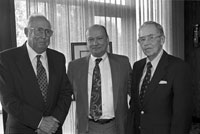
1992: November 12
- The trustees approved construction of a new student residence hall near the campus core, renovation of food service facilities, and renovation of Tower Lake apartments.
1992: December 10
- A proposal to lease thirty-five acres of property including the soccer field to the city of Edwardsville to facilitate construction of a stadium for the summer 1994 Olympic Festival received trustee approval.
1993: April 1
- The official grand opening of the Student Fitness Center, a 50,000-square-foot addition to the west side of the Vadalabene Center, took place.
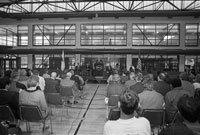
1993: September 9
- The trustees approved an academic reorganization plan that merged the schools of Fine Arts and Communications, Humanities, Sciences, and Social Sciences, plus University College, into a new College of Arts & Sciences, effective July 1, 1995.
1993: October 14
- The opening of the Art and Design Building took place.
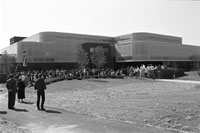
1994: January 11
- Nancy Belck became the first woman to serve as president.
1994: May 16
- A groundbreaking ceremony marked the start of construction for a Music wing addition on the south side of the Communications Building.
1994: June 24
- An evening ceremony celebrated completion of the new stadium constructed to host the U.S. Olympic Festival.
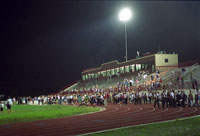
1994: July 2-6
- SIUE hosted the Olympic Festival wrestling events at the Vadalabene Center.
1994: July 8-10
- The track and field events of the festival took place in the new stadium.
1994: October 13
- Initially opened for student occupation on August 19, the official dedication of the Student Residence Hall, the first of four new residence halls, took place on this date.
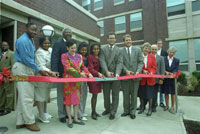
1995: January 2
- Sharon K. Hahs received appointment as the first dean of the newly-created School of Arts & Sciences effective this date.
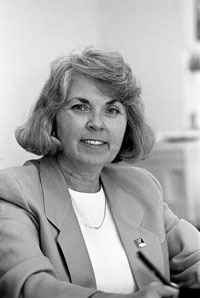
1995: January 12
- Officials announced that in future commencement ceremonies would be held at the conclusion of the fall, spring, and summer semesters.
1995: September 14
- President Belck presided at the dedication of the new music wing addition to the south side of the Communications Building.
1996: July 1
- Madison County Transit inaugurated bus service on campus, from campus to Edwardsville, and from campus to Metro Link.
1996: September 11
- Chancellor Nancy Belck announced that more than 1,000 students who had illegally charged personal long-distance phone calls to the university had to date repaid over $416,000 out of a total of more than $1,000,000 in falsified calls.
1997: January 9
- A ceremony marked the naming of the Louisa H. Bowen University Archives and Special Collections unit of Lovejoy Library after the late university archivist.
1997: January 11
- Mildred Arnold, pioneer public affairs newswriter, student yearbook advisor, and wife of founding faculty member George Arnold, passed away.
1997: September 1
- David Werner became chancellor effective this date.
1997: September 24
- A convocation event marked the fortieth anniversary of the opening of the university.
1997: October 9
- The trustees renamed: Building II as Founders Hall, Building III as Alumni Hall, the first residence hall as Woodland Hall, the second residence hall as Prairie Hall, Tower Lake as Cougar Lake, and the Tower Lake housing complex as Cougar Village.
1997: October 30
- A dedication ceremony took place for a new ground-level greenhouse that replaced an aging greenhouse atop the Science Building.
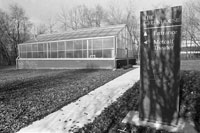
1997: December 15
- To assist faculty members to learn about and make use of new tools in their teaching and research, Library and Information Services created a Faculty Technology Center.
1998: March 14
- A Glen Carbon couple claimed to have spotted a live cougar on campus.
1998: June 11
- The trustees named the new stadium that had been constructed surrounding Bob Guelker Field in honor of alumnus Ralph Korte; renamed the Communications Building as Katherine Dunham Hall; renamed the circular central mall area as the William G. Stratton Quadrangle; and renamed the University Center for the late Delyte Morris.
1998: July 7
- Dedication of the Donal G. Myer Arboretum took place.
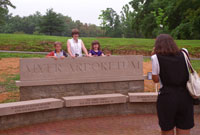
1998: August 21
- Prairie Hall, the second residence hall, opened for student occupation.
1998: October 15
- A ribbon-cutting event marked the opening of a new Chick-fil-A restaurant on the lower level of the renovated Morris University Center.
1999: March 3
- A ceremony in the building dramatized the renaming of the Communications Building as Katherine Dunham Hall.
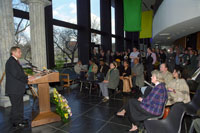
1999: March 17
- A reception in the MUC Gallery opened a retrospective exhibit of Mississippi River Festival memorabilia collected by former festival director Lyle Ward.
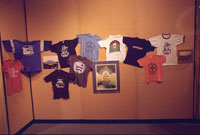
1999: May 27
- Groundbreaking took place for a new building to house the offices of the foundation and the alumni association.
1999: June 21
- Officials announced a gift of one million dollars to the School of Business to establish the Ralph and Donna Korte Fund for Leadership and Innovation in Business Education.
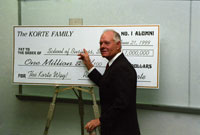
1999: August 23
- The East St. Louis Center opened a pioneering charter high school in an attempt to provide opportunity to students from the community who had previously dropped out from the local school district.
1999: September 9
- A 4,100-square-foot addition to the Student Fitness Center that doubled the existing weight training space opened on this date.
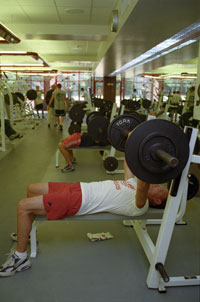
1999: November 11
- The trustees approved construction of a new School of Nursing facility in Springfield and also designated the anticipated third student residence hall as Bluff Hall.
Back To Top
2000: March 17
- Chancellor David Werner presided at the dedication of the John C. Abbott Auditorium in Lovejoy Library. Abbott had served as the founding library director from 1960 to 1981.
2000: June 7
- Sharon Hahs received appointment as provost and vice chancellor for student affairs effective this date.
2000: August 23
- The grand opening of the new Skywalk Food Court location took place.
2000: September 13
- A dedication ceremony recognized the completion of the new Engineering Building.
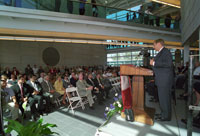
2000: October 4
- A dedication ceremony celebrated the opening of the new B. Barnard Birger Hall as the common home of the development and public affairs, alumni association, and university foundation units.
2001: March 16
- Officials announced that grades would no longer be mailed to students in the traditional manner since almost no one had complained when 11,000 pieces of mail had disappeared over the break between fall and spring semesters and interested students had simply accessed their grades on the internet.
2001: May 24
- The trustees approved an agreement allowing the university to purchase an existing building at 200 University Park Drive in University Park and to use 7,000 feet of unoccupied space as a new home for a relocated Textbook Rental operation.
2001: May 31
- To honor the family of Ernest E. and Mary Tosovsky, original property owners and longtime supporters, the university dedicated a patio next to B. Barnard Birger Hall as the Tosovsky Terrace.
2001: June 25
- Following a vandal's attack in April, on this date university workers attempted to lift The Rock, only to have the remaining portion break apart into pieces.
2001: August 27
- A groundbreaking ceremony initiated construction of the National Corn-to-Ethanol Research Center facility in University Park.
2001: November 14
- The new disc golf course opened for competition.
2002: January 17
- The Alestle reported that, effective in September 2002, the Textbook Rental function would vacate the basement of Lovejoy Library and relocate to space in University Park.
2002: August 22
- A dedication ceremony heralded the opening of a new rock climbing gym located within a converted racquetball court at the Vadalabane Center.
2002: October 7-8
- The Rock disappeared overnight from its traditional location on the campus mall, only to be discovered on October 17 by a jogger running near the soccer practice fields.
2002: November 14
- The Alestle reported that Textbook Rental staff had initiated but not yet completed a relocation move from Lovejoy Library to University Park.
2003: January 10
- The soft opening of the renovated Center Court food service area took place.
2003: March 14
- Workers installed a new replacement Rock of limestone donated by the Unimin Corporation of Pevely, Missouri. The remnant of the original rose quartz Rock subsequently went on display in the Morris University Center. The formal dedication of the new Rock occurred on April 7.
2003: March 26
- A new SIUE web radio station began broadcasting from a space in the basement of the Morris University Center.
2003: September 22
- Officials dedicated the new National Corn-to-Ethanol Research Center in University Park.
2003: October 13
- Following two years of renovation, the official reopening of the Morris University Center took place.
2004: February 2
- Gina Hays became the first woman to serve as chief of the university police force.
2004: July 1
- Vaughn Vandegrift became chancellor effective this date.
2004: October 18
- The National Corn-To-Ethanol Research Center accomplished its initial ethanol production.
2004: November 9
- Sale of the original theater seats from the Dunham Hall auditorium made possible installation of the first replacement seats in the life of the facility.
2004: November 12
- The groundbreaking ceremony for a new University Park building to house the newly-authorized School of Pharmacy took place.
2005: May 12
- The trustees approved the implementation of an extensive new wayfinding or signage program.
2005: October 14
- The trustees authorized construction plans for the fourth student residence hall.
2006: March 9
- The trustees designated the fourth student residence hall as Evergreen Hall.
2006: April 23
- The SIUE Cricket Club's new cricket patch opened at a site just north of Korte Stadium.
2006: April 28
- Professor Ronald Schaefer became the first William and Margaret Going Endowed Professor.
2006: August 1
- Officials announced a testamentary gift from the late Professor Homer Cox to the School of Business in the amount of $2,400,000.
2006: September 26
- The School of Nursing staged a dedication ceremony for the new Advanced Care Wing.
2007: January 30
- SIUE and Southwestern Illinois College entered into an innovative dual admission partnership agreement.
SIUE 50th Anniversary Timeline. Copyright ©2007, Stephen Kerber, University Archivist Lovejoy Library
Back To Top



































